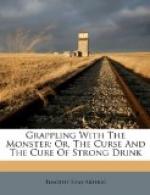“When we know the course which the alcohol takes in its passage through the body, from the period of its absorption to that of its elimination, we are the better able to judge what physical changes it induces in the different organs and structures with which it comes in contact. It first reaches the blood; but, as a rule, the quantity of it that enters is insufficient to produce any material effect on that fluid. If, however, the dose taken be poisonous or semi-poisonous, then even the blood, rich as it is in water—and it contains seven hundred and ninety parts in a thousand—is affected. The alcohol is diffused through this water, and there it comes in contact with the other constituent parts, with the fibrine, that plastic substance which, when blood is drawn, clots and coagulates, and which is present in the proportion of from two to three parts in a thousand; with the albumen which exists in the proportion of seventy parts; with the salts which yield about ten parts; with the fatty matters; and lastly, with those minute, round bodies which float in myriads in the blood (which were discovered by the Dutch philosopher, Leuwenhock, as one of the first results of microscopical observation, about the middle of the seventeenth century), and which are called the blood globules or corpuscles. These last-named bodies are, in fact, cells; their discs, when natural, have a smooth outline, they are depressed in the centre, and they are red in color; the color of the blood being derived from them. We have discovered in recent years that there exist other corpuscles or cells in the blood in much smaller quantity, which are called white cells, and these different cells float in the blood-stream within the vessels. The red take the centre of the stream; the white lie externally near the sides of the vessels, moving less quickly. Our business is mainly with the red corpuscles. They perform the most important functions in the economy; they absorb, in great part, the oxygen which we inhale in breathing, and carry it to the extreme tissues of the body; they absorb, in great part, the carbonic acid gas which is produced in the combustion of the body in the extreme tissues, and bring that gas back to the lungs to be exchanged for oxygen there; in short, they are the vital instruments of the circulation.
“With all these parts of the blood, with the water, fibrine, albumen, salts, fatty matter and corpuscles, the alcohol comes in contact when it enters the blood, and, if it be in sufficient quantity, it produces disturbing action. I have watched this disturbance very carefully on the blood corpuscles; for, in some animals we can see these floating along during life, and we can also observe them from men who are under the effects of alcohol, by removing a speck of blood, and examining it with the microscope. The action of the alcohol, when it is observable, is varied. It may cause the corpuscles to run too closely together, and to adhere in rolls; it may modify their outline,




